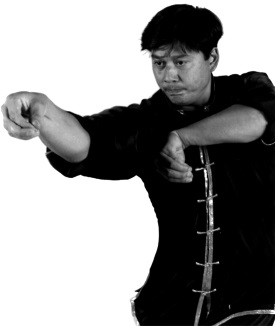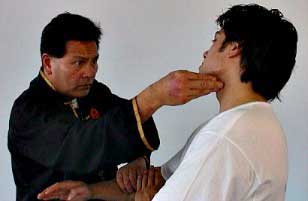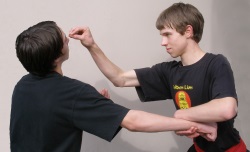The kung fu crane technique in the Chinese martial arts at Golden Lion is a technique built around deflection and avoidance of force. In terms of self- defence it is very effective at forcing an opponent off balance.

The origin of the crane style in kung fu is uncertain as its history was passed on through word-of-mouth, but the creation of the white crane style is thought to date to some point in the 1700s with variations of the style being developed since.
Fujian White Crane martial arts style is one of the constituent styles of the five ancestors. The white crane style is believed to have been developed in the Fukian province in China, a region with abundant cranes, and is attributed to Fang Qiniang who was a female martial artist at the time. She reputedly tried to scare a crane by shooing it with a stick, but it countered every blow by blocking with its wings, feet and beak. The crane style mimics the body parts and methods used by the crane as the basis for all its techniques.
The kung fu Crane’s Beak is a soft style technique which utilises circular movements to deflect an attack. The hand portion of the technique involves placing all the fingertips together and curling the hand back towards the forearm to form a hook shape (the beak). The crane’s beak uses both hands in order to block an attack, and line its user up for a counter strike. This is done by using one hand to hook around the opponents strike and guide it away from its target, opening the opponent up for a strike to a critical pressure point such as the eyes, temple or throat.

Kung fu crane technique on a dim mak pressure point
The actual martial arts strike is a pecking motion which drives all the force of the attack to a single point, this allows for great damage to a vulnerable area with little force. The main objective of the kung fu crane technique is to avoid a strike by directing an opponent’s force away from the body, but the hand technique alone may be insufficient at doing so in a soft manner, and therefore the foot work becomes crucial to the success of the style. The stance used for the crane’s beak is a medium height cat stance, and this enables the user to side- step away from an opponent’s attack, then twist the body from the hips to extend their reach to allow maximum effectiveness of the strike.
This kung fu crane technique allows someone of a small, slender build to defend against a hard style such as the tiger style. The main strength of this style is that it does not meet force with force, but redirects the opponents strike away from the body. This makes it very proficient at countering a hard stylist who aims to win by overwhelming their opponent with force.
The benefit of this fighting strategy is that it enables a person without the muscle mass or the weight to throw a knockout punch to win with speed, precision and agility. The crane’s beak is generally used to strike at an angle, aiming to go around the attack and counter with blows to the side of the head/neck although plucking the eyes is also a main target.
The crane’s beak is a technique largely built around deflection and avoidance of force. In terms of self-defence it is very effective at forcing an opponent off balance and enables the user to strike to vulnerable areas. It does however require great speed, accuracy and agility in order to do this. In terms of street application, the crane’s beak does have its limitations.
Forming the beak shape with the hands exposes the fingers to large amounts of force which can make them liable to break in a fight. Conditioning of the hands and fingers is a must. However the basic motions of avoidance and deflection are invaluable in a fight setting, but the same success can be achieved in a safer manner by using a fist with the draw back of losing the hooking and therefore the control. An attempt at reducing this shortcoming has been overcome by hybridising the style to form the tiger-crane style.
Crane style demands perfect timing, balance and coordination, so the practitioner must train diligently in order to achieve the level required. Training to use the crane’s beak effectively means repetitive one-on-one application training to make the technique second nature to the user. This repetition is typical of the crane, which is characterised for concentration and grace.

The main objective of the crane’s beak is never to attack, but to block and counter attack with minimal force and in circular motions. The crane itself has little muscle mass and has hollow bones which may appear to give it a disadvantage in a fight. However the secret of the kung fu crane style is to appear to be losing by waiting for an attack, but in reality the stylist wants to opponent to attack as most of the crane techniques rely on creating an opening for the counter strike. This also makes many of the strategies utilised by the crane ideal for a street setting as some of the hard styles techniques are “hit first, hit hard” which leaves practitioners up for liability for injuries inflicted. However waiting for an attack and being effective at using it to create an opening is purely a self defence tactic, thereby reducing this risk of criminal charges.
Thanks to Jim Griffiths, Berwick Chinese Martial Arts Kung Fu Student, for this contribution.
